By my last blog, I introduced to you the “Naka-hechi” Kumano Kodo, one of ancient routes connecting to the Kumano Sanzan (the three grand shrines) in the Kii Peninsula, referring to my own 2-day & 39-kilometer-long pilgrimage from Kii Tanabe City to the Kumano Hongu Grand Shrine. The routes and the grand shrines have been designated by UNESCO as World Heritage Sacred Sites and Pilgrimage Routes in the Kii Mountain Range of Japan.
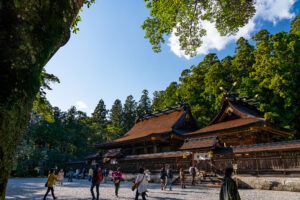 Kumano Hongu Taisha
Kumano Hongu Taisha
 Kumano Hayatama Taisha
Kumano Hayatama Taisha
 Kumano Nachi Taisha
Kumano Nachi Taisha
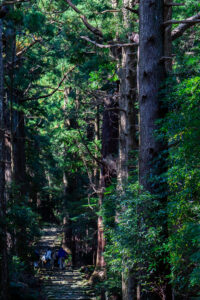 Kodo to Nachi Taisha
Kodo to Nachi Taisha
By this blog, let me talk more about the Kumano Sanzan. “Sanzan” refer to the three (San) shrines or temples (Zan) and the Kumano Sanzan include the Kumano Hongu Taisha (“Taisha” means a grand shrine), the Kumano Hayatama Taisha and the Kumano Nachi Taisha in the Kumano region, deep in mountainous area in the southern part of the Kii Peninsula. The three Taisha are connected to each other via the Kumano Kodo pilgrimage routes. Each shrine was initially established for worshiping its own deity in nature and, entering the Heian Era (9th ~ 12th century) the three shrines came to be worshipped together as the Kumano Sanzan. By paying my November visits to the three shrines for worshiping, I was able to complete my pilgrimage to the Kumano.
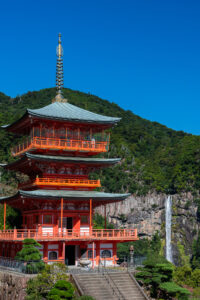 Pagoda at Nachi Taisha
Pagoda at Nachi Taisha 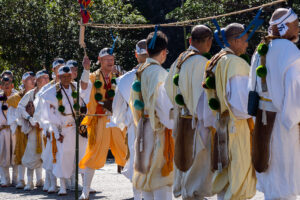 Yamabushi
Yamabushi
The photo above (left) is a shot of the Nachi Taisha. Taisha refers to a grand shrine but it possesses a five-storied pagoda, a typical Buddhist architecture. The photo (right) brings you a religious scene at the Nachi Taisha where apprentice “Yamabushi” (mountain ascetic monks) are taking a qualification test to make independent Yamabushi. Why do Shintoism , Buddhism and Mountain Ascetism exist by mixture? As you may recall, Shintoism is a Japanese indigenous religion worshipping nature and ancestors, while Buddhism was introduced from India to Japan in the 6th century and got support by the then Emperors. The former is polytheistic with emphasis on a present life and the latter is atheistic with emphasis on a post-mortal life. The two religions have coexisted, making fusion called Shinbutsu Shugo or syncretism. Mountain ascetism originated in worshiping mountains as sacred objects and later developed into Shugendo which incorporated with Shintoism and Buddhism and those who practice Shugendo in mountains are called Yamabushi. They practice in the Kumano mountains as its being sacred and deep mountains covered.
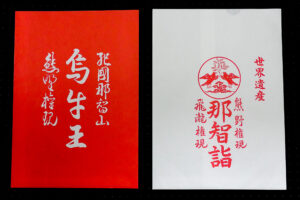
 “Shin-pu” Amulet
“Shin-pu” Amulet
The photo above is a shot of the Shin-pu, an amulet or a lucky charm, which I received at the Kumano Nachi Taisha as a divine symbol of my own visit. On the Shin-pu, many “Yata-garasu” (sacred ravens) are depicted as they are messengers of the Kumano deities. Yata-garasu are believed to have guided Emperor Jimmu, the first emperor in the Japanese history, to the Kumano when he made expedition from the west (the Kyushu Island?) to the east of the Honshu Main Island to unify Japan in ancient times. So, Yata-garasu have been worshipped as deities of guiding or steering your life. Besides, Yata-garasu is designated the symbol of the Japan Football Association. Mr.Kakunosuke Nakamura was the very person who introduced Soccer (or association football) to Japan in the 19th century and JFA has paid its respect to Mr.Nakamura by choosing Yatagarasu, the symbol of Kumano where Mr.Nakamura was born.
I believe by visiting the Kumano Sanzan you will be able to see the Japan’s unique religious aspects as well as very magnificent scenery of the Kumano mountanins. Why don’t you plan to visit after COVID-19 is put under control?
By Jin Shibata
Email jin.shibata@i3ws.co.jp

Comment